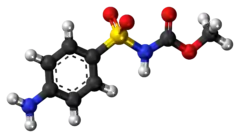 | |
 | |
| Names | |
|---|---|
| Preferred IUPAC name
Methyl (4-aminobenzene-1-sulfonyl)carbamate | |
| Identifiers | |
3D model (JSmol) |
|
| ChEBI | |
| ChemSpider | |
| ECHA InfoCard | 100.020.071 |
| KEGG | |
PubChem CID |
|
| UNII | |
CompTox Dashboard (EPA) |
|
| |
| |
| Properties | |
| C8H10N2O4S | |
| Molar mass | 230.241 g/mol |
| Density | 1.419 g/mL |
Except where otherwise noted, data are given for materials in their standard state (at 25 °C [77 °F], 100 kPa).
Infobox references | |
Asulam is a herbicide invented by May & Baker Ltd , internally called M&B9057,[1] that is used in horticulture and agriculture to kill bracken[2][3] and docks.[4] It is also used as an antiviral agent. It is currently marketed, by United Phosphorus Ltd - UPL, as "Asulox" which contains 400 g/L of asulam sodium salt.
Asulam was declared not approved by the Commission Implementing Regulation (EU) No 1045/2011 of 19 October 2011 concerning the non-approval of the active substance asulam. Concerns included: lack of evidence concerning the fate of the toxic metabolite sulfanilamide and other metabolites; the poorly characterised nature of the impurities potentially present in the technical-grade product; toxicity to birds. This decision is given in with Regulation (EC) No 1107/2009 of the European Parliament and of the Council concerning the placing of plant protection products on the market, and amending Commission Decision 2008/934/EC (http://eur-lex.europa.eu/LexUriServ/LexUriServ.do?uri=OJ:L:2011:275:0023:0024:EN:PDF).
References
- ↑ "ChemSpider – Asulam – C8H10N2O4S". Retrieved 30 September 2011.
- ↑ R. J. Pakemana, M. G. Le Ducb and R. H. Marrs (1998). "An assessment of aerially applied asulam as a method of long-term bracken control". Journal of Environmental Management. 53 (3): 255–262. doi:10.1006/jema.1998.0207.
- ↑ C. S. R. Snow and R. H. Marrs (1997). "Restoration of Calluna heathland on a bracken Pteridium-infested site in north west England". Biological Conservation. 81 (1–2): 35–42. doi:10.1016/S0006-3207(96)00147-4.
- ↑ R. I. Speight and J. B. Whittaker (1987). "Interactions Between the Chrysomelid Beetle Gastrophysa viridula, the Weed Rumex obtusifolius and the Herbicide Asulam". The Journal of Applied Ecology. 24 (1): 119–129. doi:10.2307/2403791. JSTOR 2403791.
Further reading
- Asulam in the Pesticide Properties DataBase (PPDB)